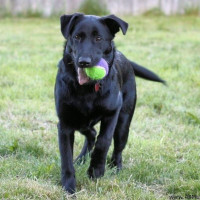Appearance of the German Sheprador
|
| It's often said that the handsome German Sheprador resembles a leaner Labrador Retriever with a greater variety of coat colors. Of course, the first generation of puppies produced will tend to vary in appearance, with some looking more like Labrador Retrievers and others more like their German Shepherd parents. Thanks to the continued breeding of German Sheprador lines, a more uniform-looking breed is beginning to emerge. Although pedigree dogs tend to be black and tan, they can be jet-black, cream or even brown all over. The double coat tends to be straight, short and thick, and shedding can be heavy at certain times of the year. Ears can be floppy, like the Labrador Retriever, or upright, like the German Shepherd. Their eyes are dark brown and melancholy, while their large nose is always black. The German Sheprador's muzzle is generally well developed and long. Their body is robust, with straight limbs. Their tails are generally long and of medium thickness. Adult dogs generally weigh between 34 and 43 kilos and measure between 51 and 68.5 centimeters at the withers. Males are generally taller and broader than females, with greater muscle mass. |
Temperament of the German Sheprador
|
| A German Sheprador may have more of a Labrador Retriever personality, or rely more on the temperament of its German Shepherd parent. Most first-generation dogs fall somewhere in the middle. Most German Shepradors will be approachable, friendly and social, much like their Labrador Retriever ancestors, although it's not unusual for them to be indifferent and suspicious, as their German Shepherd parents are. Loyalty is a common trait, and most dogs of the breed show deep devotion to their families, eager to protect them at all times. A breed with a love of children, most German Shepradors enjoy spending time with younger family members and having fun. Their laid-back nature tends to make them a good playmate, although their large size means they should always be supervised when with children. To ensure that they accept children into the household, they need to be exposed to them from an early age, and boundaries need to be emphasized early on in the relationship. Curious and intelligent by nature, German Shepradors need plenty of mental stimulation to prevent boredom from setting in. An under-stimulated dog is likely to become destructive at home and develop harmful tendencies, such as digging up or destroying furniture. |
Needs and activities of the German Sheprador
|
| The German Sheprador is a fairly active dog. It is recommended that he gets enough exercise to maintain his weight and health. He may tend to put on weight if not exposed to regular physical activity. He'll be happier and better behaved if he has a home with a large yard in which he can be allowed to run and play. He may also enjoy joining you for a leisurely stroll. The dog park is an ideal place for the German Sheprador, he'll appreciate the ability to get out, run and play with other dogs. He needs regular exercise to keep from chewing or barking excessively. |
Maintenance of the German Sheprador
|
| There isn't much information on the German Sheprador, however, we can study parent breeds to determine the type of maintenance required by the hybrid breed. The Labrador Retriever has a double coat. The top coat is short, thick and straight. The undercoat is soft and weather-resistant. He sheds a little, but this won't require much extra grooming. Brush him daily with a soft bristle brush. Some experts also recommend vacuuming afterwards. He should be bathed once every two months. Of course, if he finds a mud puddle or something unattractive to roll around in, you may need to wash him more often. It's especially important to clean your German Sheprador's ears regularly. Use a damp cotton ball to wipe the inside of his ears. Be sure to check them regularly for odor or redness, which could indicate an infection. The Labrador Retriever's soft ears make it prone to such things. German Shepherds have a medium-length double coat to protect their tender skin from snow and rain, but they are also resistant to dirt. Some German Shepherds have long hair, but in general, they have a medium-length coat. Sometimes, the German Shepherd's outer coat will be stiff to the touch. He may be prone to shedding a few hairs throughout the year, he will also have a blow in which he suffers significant shedding twice a year. Brush him two or three times a week with a smooth bristle brush. He should only be bathed when necessary. German Shepherds are generally very clean and often considered odorless. It's a good idea to take advantage of the fact that German Shepherds like to chew, so give them dental chews to keep their teeth clean, in addition to regular brushing, and promote overall dental health. In general, German Shepradors will look their best with daily brushing. |









 English (United Kingdom)
English (United Kingdom)